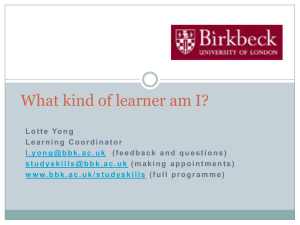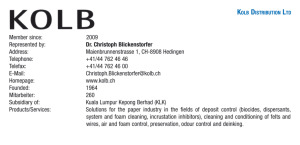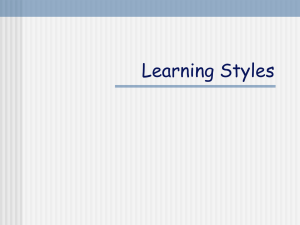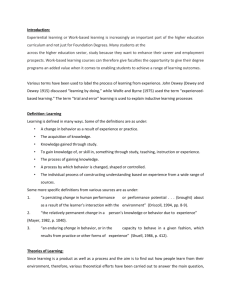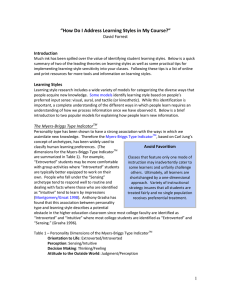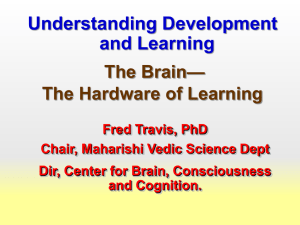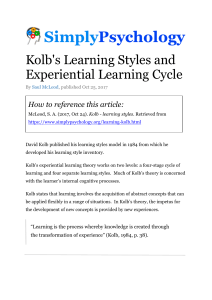Kolb
advertisement
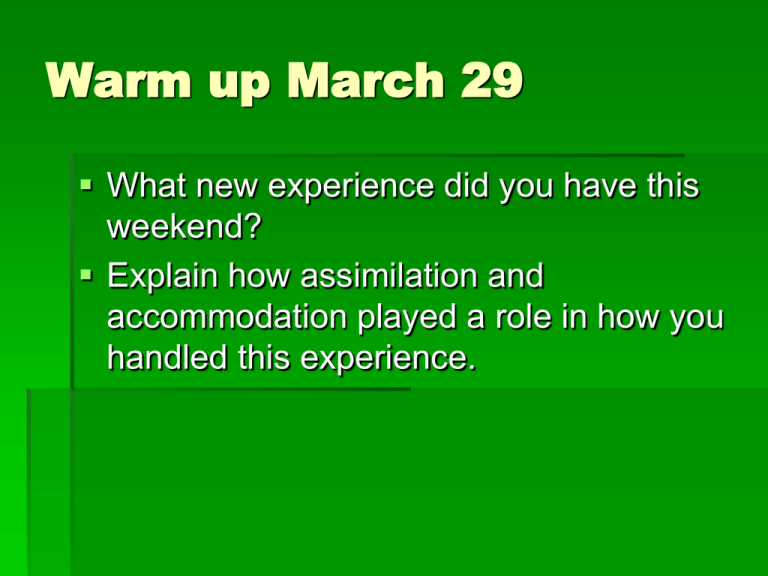
Warm up March 29
What new experience did you have this
weekend?
Explain how assimilation and
accommodation played a role in how you
handled this experience.
David
Kolb
ELT & LSI
Experiential learning theory (ELT), and learning
styles inventory (LSI).
4 distinct learning styles (or preferences),
based on a four-stage learning cycle.
Way to understand individual people's
different learning styles, and also an
explanation of a cycle of experiential
learning that applies to us all.
Cycle of learning
Kolb includes this 'cycle of learning' as a
central principle in his experiential learning
theory.
“immediate or concrete experiences' provide a
basis for 'observations and reflections'. These
'observations and reflections' are assimilated and
distilled into 'abstract concepts' producing new
implications for action which can be 'actively
tested' in turn creating new experiences.
Learning Cycle
Kolb's model therefore works on two
levels - a four-stage cycle:
Concrete Experience - (CE)
Reflective Observation - (RO)
Abstract Conceptualization - (AC)
Active Experimentation - (AE)
Learning Styles
Four-type definition of learning styles, (each
representing the combination of two preferred
styles, rather like a two-by-two matrix of the
four-stage cycle styles, as illustrated below),
for which Kolb used the terms:
Diverging (CE/RO)
Assimilating (AC/RO)
Converging (AC/AE)
Accommodating (CE/AE)
Axis
A typical presentation of Kolb's two continuums is that
the east-west axis is called the Processing Continuum
(how we approach a task), and the north-south axis is
called the Perception Continuum (our emotional
response, or how we think or feel about it).
These learning styles are the combination of two lines
of axis (continuums) each formed between what Kolb
calls 'dialectically related modes' of 'grasping
experience' (doing or watching), and 'transforming
experience' (feeling or thinking):
In layman’s terms
In other words we choose our approach to the
task or experience ('grasping the
experience') by opting for 1(a) or 1(b):
1(a) - though watching others involved in the
experience and reflecting on what happens
('reflective observation' - 'watching') or
1(b) - through 'jumping straight in' and just
doing it ('active experimentation' - 'doing')
And at the same time we choose how to
emotionally transform the experience
into something meaningful and useful by
opting for 2(a) or 2(b):
2(a) - through gaining new information by
thinking, analyzing, or planning ('abstract
conceptualization' - 'thinking') or
2(b) - through experiencing the 'concrete,
tangible, felt qualities of the world'
('concrete experience' - 'feeling')
Doing (Active
Experimentation
- AE)
Watching
(Reflective
Observation RO)
Feeling
(Concrete
Experience - CE)
Accommodating
(CE/AE)
Diverging
(CE/RO)
Thinking
(Abstract
Conceptualizatio
n - AC)
Converging
(AC/AE)
Assimilating
(AC/RO)
Warm up March 31st
In what ways have you learned through
observation?
In what ways have you seen a sibling or
younger cousin or younger person learn
from your behaviour?
Bandura
Observational learning.
Also known as vicarious learning, social
learning, or modeling.
Is a function of observing, retaining and
replicating behaviour.
• Attention to the model - In order for the behaviour to be
learned, the observer must see the modeled behaviour
• Retention of details – The observer must be able to
recall the modeled behaviour
• Motor reproduction – The observer must have the motor
skills to reproduce the action, the observer must also
have the motivation to carry out the action
• Motivation and opportunity – The observer must be
motivated to carry out the action they have observed and
remembered, and must have the opportunity to do so.
Motivations may include past reinforcement, promised
incentives, and vicarious reinforcement. Punishment may
discourage repetition of the behaviour
Behaviourism
Self-regulation -- controlling our own
behavior -- is the other “workhorse” of
human personality. Here Bandura
suggests three steps:
1. Self-observation. We look at
ourselves, our behavior, and keep tabs
on it.
2. Judgment. We compare what we see with a
standard. For example, we can compare our
performance with traditional standards, such as
“rules of etiquette.” Or we can create arbitrary
ones, like “I’ll read a book a week.” Or we can
compete with others, or with ourselves.
3. Self-response. If you did well in comparison
with your standard, you give yourself rewarding
self-responses. If you did poorly, you give
yourself punishing self-responses. These selfresponses can range from the obvious (treating
yourself to a sundae or working late) to the more
covert (feelings of pride or shame).
Therapy
Modeling therapy
Used with phobics. They watch one person
do what they are afraid to do and are more
likely to participate or copy because it has
been modelled.
Web Quest
With a partner – take the Bandura
Webquest and find answers to each
questions.
